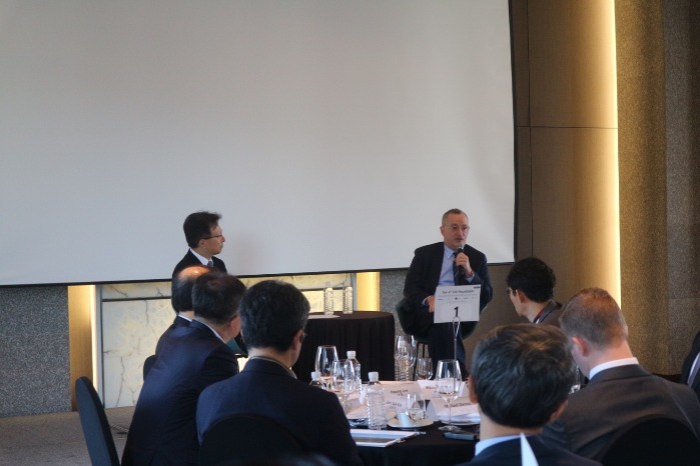Asset management
Fed rate likely to be 2-4% over next decade: Oaktree's Howard Marks
The US' onshoring trends will lead to high inflation for years, Oaktree's co-chairman says
By Nov 15, 2023 (Gmt+09:00)
2
Min read
Most Read
LG Chem to sell water filter business to Glenwood PE for $692 million


KT&G eyes overseas M&A after rejecting activist fund's offer


Kyobo Life poised to buy Japan’s SBI Group-owned savings bank


StockX in merger talks with Naver’s online reseller Kream


Meritz backs half of ex-manager’s $210 mn hedge fund



Investors are experiencing the third “sea change,” facing the Federal Reserve’s rate hikes and its impact on economies and businesses, said Howard Marks, Oaktree Capital Management’s co-founder and co-chairman, at an investors’ meeting in Seoul hosted by The Korea Economic Daily last week.
The change is fundamental and long-lasting rather than cyclical, the 77-year-old billionaire said.
“The first sea change was in 1978 when I worked at Citibank. I was asked to start activities in high-yield bonds – of which the returns could be sufficient to compensate for risks – and it signaled greater investment growth. The second sea change came soon thereafter as former Fed Chairman Paul Volcker raised the Fed funds rate to 20%. Nobody could figure out how to stop inflation in the mid-teens percentage range until then.”
He believes that today’s interest rates are not high but normal, and that the rates will be the rule going forward.
Over the next five to 10 years, the Fed funds rate is more likely to be 2-4% than between 0-2%, which means that investors have to engage in a different form of behavior than in recent years, according to his forecast.
Although it is hard to fully explain the causes of inflation, he picked globalization and enhanced productivity as major drivers of low inflation in the past.
“From 1990 to 2015, the price of consumer durables fell by around 40% in real terms as globalization led to inexpensive home appliances. Advances in productivity and technology probably contributed to the absence of inflation.”
“But the money spent to pull the world, especially the US, out of the pandemic combined with the supply chain snags after the pandemic was over. This has produced the classic explanation of inflation – too much money chasing too few goods.”
He believes that inflation will be somewhat higher due to onshoring like building chipmaking plants in the US via the CHIPS Act. The US aims to secure supply despite high prices of semiconductors produced in the country, therefore, the impact of globalization on price reductions won’t be as powerful as in the past, he explained.
The low interest rates in the past helped asset owners and borrowers at the expense of bargain hunters and lenders, but that has changed, he noted.
“I think that the lender is out of a low return world and back to a full return world. It means that debt investments should do better in the years ahead than they have leveraged. We lived through the easy period; the coming period will be a little harder.”
Write to Jihyun Kim at snowy@hankyung.com
Jennifer Nicholson-Breen edited this article.
More to Read
-
 Real estateMirae Asset to be named Korea Post’s core real estate fund operator
Real estateMirae Asset to be named Korea Post’s core real estate fund operatorApr 29, 2025 (Gmt+09:00)
-
 Asset managementMirae Asset bets on China as Korean investors’ US focus draws concern
Asset managementMirae Asset bets on China as Korean investors’ US focus draws concernApr 27, 2025 (Gmt+09:00)
-
 Alternative investmentsMeritz backs half of ex-manager’s $210 mn hedge fund
Alternative investmentsMeritz backs half of ex-manager’s $210 mn hedge fundApr 23, 2025 (Gmt+09:00)
-
 Real estateRitz-Carlton to return to Seoul, tapped by IGIS Asset for landmark project
Real estateRitz-Carlton to return to Seoul, tapped by IGIS Asset for landmark projectApr 22, 2025 (Gmt+09:00)
-
 Real estateS.Korean gaming giant Netmarble eyes headquarters building sale
Real estateS.Korean gaming giant Netmarble eyes headquarters building saleApr 18, 2025 (Gmt+09:00)
Comment 0
LOG IN


